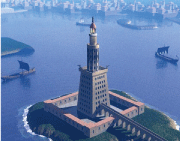E-Archive
Off the Beaten Track
in Vol. 23 - September Issue - Year 2022
Pharos

Depicted on two ancient Roman coins

The diver felt his way through the murky water with extreme caution. Suddenly a huge, perfectly-cut square block of stone appeared in front of his face mask, followed by another block and then by yet another one. A few meters away, he gasped with surprise as a colossal statue of a male figure came into view. What had he found?
*****
Their conquest of much of the Mediterranean in the fourth century BC allowed the Greeks to visit the ancient civilizations of the Egyptians, Persians and Babylonians. As they marveled at the impressive constructions they found in these distant lands, they began to keep a record of what they saw for future memory. The 1st century BC Greek historian Diodorus Siculus first referred to a list of “seven sights of the world” that the later Greek poet Antipater of Sidon defined as “the seven wonders of the world”.
One of the landmarks later added to this list was the lighthouse at Alexandria. After conquering Egypt, Alexander the Great founded the city of Alexandria about thirty kilometers west of the Nile River Delta in 332 BC. Upon his death in 323 BC, his generals divided his empire and one of them declared himself the king of Egypt under the name of Ptolemy I Soter in 305 BC. Under his rule, Alexandria became rich and prosperous. Trade expanded enormously, both with cities along the Nile and with ships coming from across the Mediterranean. Both as a symbol of the city and to guide the numerous trading vessels into its busy harbor, Ptolemy I ordered the construction of an enormous lighthouse on the island of Pharos, located at the opening of the harbor. The Greek architect Sostratus of Knidos began work in 290 BC and completed the structure about twelve years later, under the rule of Ptolemy II Philadelphus, Soter’s son.
The lighthouse was built with solid blocks of limestone consisting of three tiers, all sloping slightly inwards. Some sources claim that the limestone blocks were covered with slabs of white marble held together by molten lead to protect against the elements. The three levels rested on a six-meter high stone platform that acted as the foundation of the building. The lowest level was a 30x30 meter square building about 75 meters high. The entrance to this building was not at the base of the structure, but part way up and reached by a 200-meter long ramp supported by arches. Inside this part of the structure was a wide spiral ramp on which supplies were carried to the top of the first level in carts drawn by animals. On top of this lowest level was an octagonal tower about 35 meters high. The lighthouse reached its final height with the construction of an eighteen-meter tall cylindrical structure on top of the octagonal tower. The interior of the upper two levels had a shaft with a dumbwaiter to carry firewood and other supplies to the top. The cylinder was completed by an open cupola where a large curved mirror, probably made of polished bronze, reflected the light of a huge fire during the night. A large statue of Poseidon, the god of the sea, was placed on the roof of the cupola. Almost 140 meters tall and for centuries the second-tallest man-made construction in the world, after the Great Pyramid of Giza, the lighthouse was a technological triumph. It is said that ships could see its reflected light by night or the smoke from its fire by day at a distance of over fifty kilometers. Apparently the lighthouse became a tourist attraction, since food was sold to visitors at the observation platform at the top of the first level. For the more adventurous, an internal staircase led to a small balcony at the top of the octagonal tower.
The lighthouse soon acquired the name of Pharos, the island on which it was built. This name became the etymological origin of the word “lighthouse” or “spotlight” in Greek, Persian, Bulgarian and in the Romance languages Italian and Spanish (faro), Portuguese (farol), French (phare) and Romanian (far).
The lighthouse succumbed to the effects of three strong earthquakes in 956, 1303 and 1323. In 1480 most of the building’s stones were used to build a fortress still standing on the island of Pharos. In 1994 French archeologist Jean-Yves Empereur discovered many huge limestone blocks and a statue, presumably of Poseidon, on the seabed. The area is now an underwater archeological park, where divers can explore the remains of the great Pharos lighthouse.
By Giovanni Gregorat, Contributing Editor MFN



























